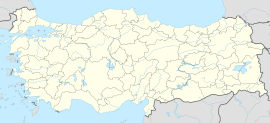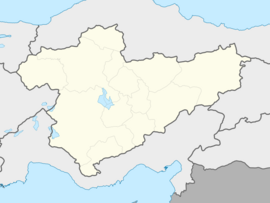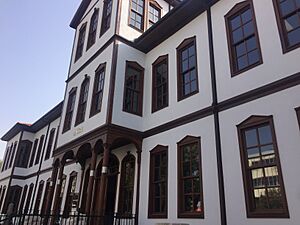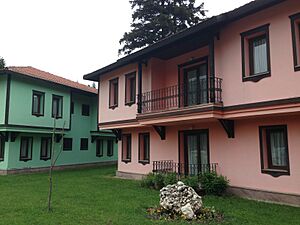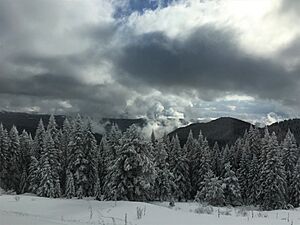Çankırı facts for kids
Quick facts for kids
Çankırı
|
||
|---|---|---|
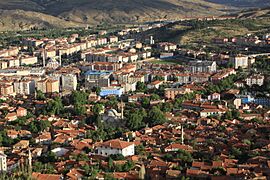
General view of Çankırı
|
||
|
||
| Country | Turkey | |
| Province | Çankırı | |
| District | Çankırı | |
| Elevation | 800 m (2,600 ft) | |
| Population
(2021)
|
90,564 | |
| Time zone | TRT (UTC+3) | |
| Area code | 0376 | |
Çankırı is a city in Turkey. It is located about 140 kilometers (87 miles) northeast of Ankara, the capital city. Çankırı sits about 800 meters (2,500 feet) above sea level.
This city is the main center of Çankırı Province and Çankırı District. In 2021, about 90,564 people lived there. Long ago, Çankırı was known by other names like Gangra and Germanicopolis.
Contents
History of Çankırı
Çankırı has a very long and interesting history. In ancient times, it was called Gangra. Later, it was known as Germanicopolis. People also called it Changra, Kandari, Kanghari, or Kangri.
Gangra was once an important town in a region called Paphlagonia. It might have even been the capital city. The last king of Paphlagonia, named Deiotarus Philadelphus, lived there. However, some ancient writers described it as just a "small town and a garrison" (a military base).
There's a fun story about how Gangra got its name. A writer from the 1st century BC said a goatherd (someone who looks after goats) built the town. He supposedly found one of his goats wandering there. The word gangra meant "a goat" in the local language.
Roman and Byzantine Times
After King Deiotarus died around 6/5 BC, Gangra became part of the Roman province of Galatia. The older town was built on a hill behind where the city is today. You can still see the ruins of an old fortress there. The Roman city was built where modern Çankırı now stands.
In the 2nd century AD, the city was renamed Germanicopolis. This name honored a Roman general named Germanicus or perhaps Emperor Claudius. It kept this name until the time of Emperor Caracalla.
During Christian times, Gangra became an important religious center. Hypatios, a bishop from Gangra, is considered a saint. He was killed by a group called Arians when he was returning from a big meeting of church leaders called the First Council of Nicaea in 325 AD.
In the 4th century, an important church meeting, the Synod of Gangra, took place here. During this meeting, church leaders discussed and made rules about certain religious practices. These rules are known as the Canons of Gangra. They were later accepted by a larger council in 451 AD.
Many Rulers
Over many centuries, different groups ruled Çankırı. These included the Hittites, Persians, ancient Greeks, Parthians, Pontic Greeks, Galatians, Romans, and Byzantine Greeks. Later, the Seljuks took over, and finally, the Ottoman Turks. You can still see signs of this long history throughout the city.
The city's name has stayed similar across different languages. Arabs called it Hangara, Jews called it Gagra, and Turks called it Tzungra, Kângıri, or Çankıri.
Climate in Çankırı
Çankırı has a climate with hot, dry summers and cold, snowy winters. This type of weather is called a dry summer continental climate. May is usually the month with the most rain, while July is the driest.
| Climate data for Çankırı (1991–2020, extremes 1929–2023) | |||||||||||||
|---|---|---|---|---|---|---|---|---|---|---|---|---|---|
| Month | Jan | Feb | Mar | Apr | May | Jun | Jul | Aug | Sep | Oct | Nov | Dec | Year |
| Record high °C (°F) | 17.6 (63.7) |
22.0 (71.6) |
29.0 (84.2) |
31.0 (87.8) |
35.5 (95.9) |
39.6 (103.3) |
42.4 (108.3) |
41.8 (107.2) |
39.8 (103.6) |
34.2 (93.6) |
25.1 (77.2) |
18.2 (64.8) |
42.4 (108.3) |
| Mean daily maximum °C (°F) | 3.9 (39.0) |
7.0 (44.6) |
12.8 (55.0) |
18.3 (64.9) |
23.5 (74.3) |
28.0 (82.4) |
32.0 (89.6) |
32.2 (90.0) |
27.5 (81.5) |
20.9 (69.6) |
12.4 (54.3) |
5.7 (42.3) |
18.7 (65.7) |
| Daily mean °C (°F) | −0.4 (31.3) |
1.5 (34.7) |
6.0 (42.8) |
11.0 (51.8) |
15.9 (60.6) |
20.1 (68.2) |
23.4 (74.1) |
23.3 (73.9) |
18.5 (65.3) |
12.7 (54.9) |
5.5 (41.9) |
1.4 (34.5) |
11.6 (52.9) |
| Mean daily minimum °C (°F) | −3.8 (25.2) |
−2.9 (26.8) |
0.1 (32.2) |
4.2 (39.6) |
8.7 (47.7) |
12.3 (54.1) |
14.7 (58.5) |
14.6 (58.3) |
10.1 (50.2) |
5.8 (42.4) |
0.2 (32.4) |
−2.0 (28.4) |
5.2 (41.4) |
| Record low °C (°F) | −25.0 (−13.0) |
−24.0 (−11.2) |
−20.5 (−4.9) |
−8.9 (16.0) |
−3.0 (26.6) |
1.6 (34.9) |
4.3 (39.7) |
4.6 (40.3) |
−2.0 (28.4) |
−6.3 (20.7) |
−19.4 (−2.9) |
−18.8 (−1.8) |
−25.0 (−13.0) |
| Average precipitation mm (inches) | 41.6 (1.64) |
31.7 (1.25) |
38.1 (1.50) |
45.2 (1.78) |
57.8 (2.28) |
45.5 (1.79) |
20.4 (0.80) |
22.9 (0.90) |
20.0 (0.79) |
32.5 (1.28) |
26.3 (1.04) |
45.9 (1.81) |
427.9 (16.85) |
| Average precipitation days | 10.40 | 9.27 | 9.90 | 11.43 | 13.40 | 11.10 | 4.83 | 5.00 | 5.17 | 7.67 | 7.13 | 10.23 | 105.5 |
| Mean monthly sunshine hours | 68.2 | 107.4 | 164.3 | 198.0 | 241.8 | 282.0 | 328.6 | 306.9 | 260.4 | 189.1 | 123.0 | 62.0 | 2,331.7 |
| Mean daily sunshine hours | 2.2 | 3.8 | 5.3 | 6.6 | 7.8 | 9.4 | 10.6 | 9.9 | 8.4 | 6.1 | 4.1 | 2.0 | 6.3 |
| Source: Turkish State Meteorological Service | |||||||||||||
Economy and Industry
Farming in Çankırı
Farmers in Çankırı grow many different crops. These include important foods like wheat, corn, and beans. They also grow fruits such as apples.
Local Industries
Most of the factories and businesses are located near the center of Çankırı city. The town of Korgun also has a lot of industry. Other towns with industrial areas are Şabanözü, Çerkeş, Ilgaz, Kurşunlu, and Yapraklı.
Education
Çankırı is home to Çankırı Karatekin University. This university was started in 2007. It offers many different courses for students.
Famous People from Çankırı
- Ankaralı Namık (1976–2015): A very popular folk music artist. He was known for his songs about Ankara's folk culture.
- Ahmet Çakar (born 1962): A medical doctor who used to be a FIFA football referee. He is also a well-known sports TV commentator.
- Hilal Kaplan (born 1982): A Turkish woman journalist known for her writings on Islamic topics.
Images for kids
See also
 In Spanish: Çankırı para niños
In Spanish: Çankırı para niños



